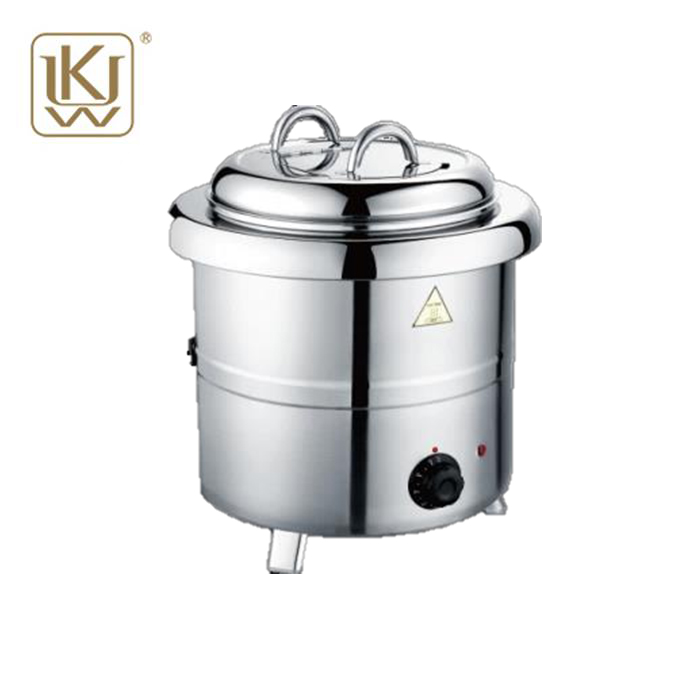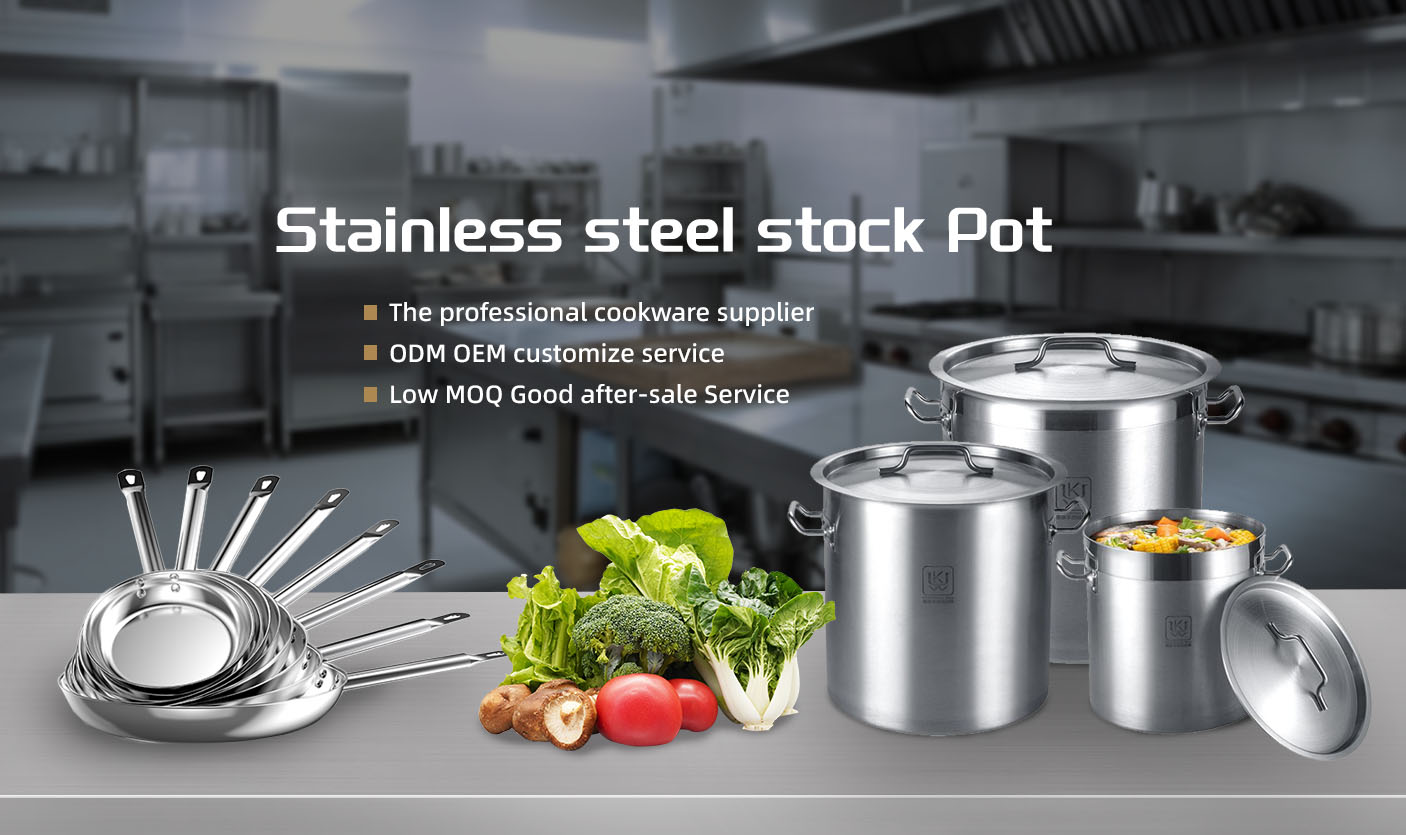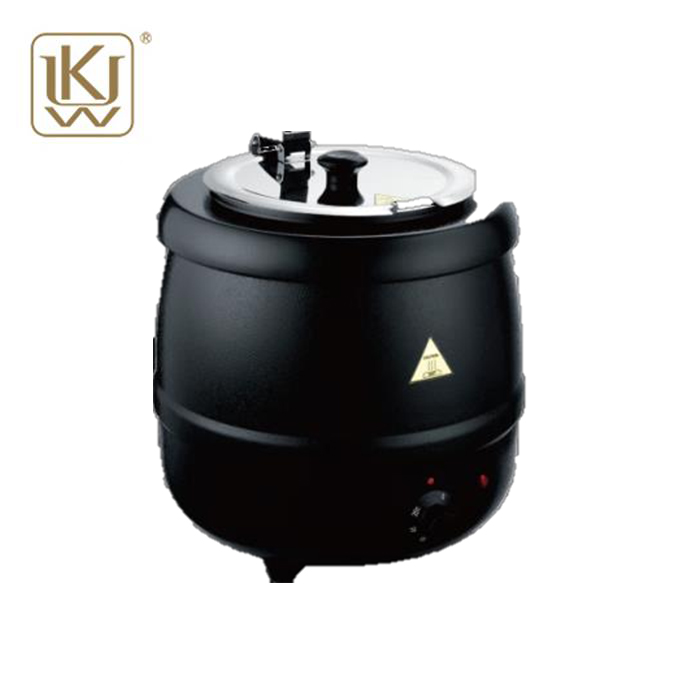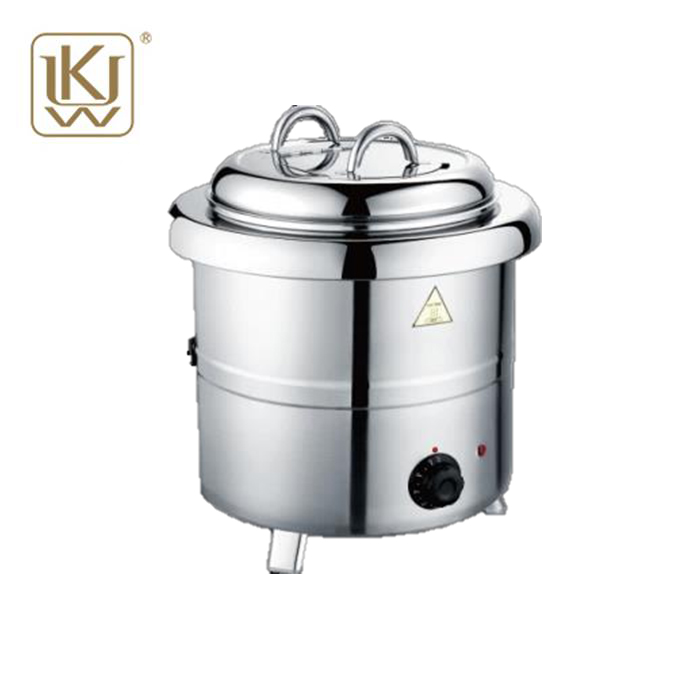Commercial Electric Soup Pot
- Product Information
The Commercial Electric Soup Pot is a stainless steel electric soup pot for heating and keeping liquid foods warm. Designed with a size of 380×380×410 mm and a capacity of 13.0 liters, it is suitable for use in commercial kitchen environments to provide continuous heating and keeping foods warm. Its simple operation makes it easy for even kitchen novices to use it. Overall, it provides users with a convenient and efficient cooking experience, making kitchen work easy and comfortable.

Commercial Electric Soup Pot Parameters:
| CODE | Dimension(mm) | VOL.(L) |
| SK13AS | 380*380*410 | 13.0L |
Commercial Electric Soup Pot Features:
Excellent material: The Commercial Electric Soup Pot is made of stainless steel, which has good corrosion resistance. It can resist the erosion of acidic or alkaline food ingredients, such as the acidic ingredients of tomato soup or alkaline noodle soup, and its service life can reach several years. The strength of stainless steel is also extremely high, which can withstand the collision and scratches in daily kitchen operations, ensuring that the Commercial Electric Soup Pot can remain in good condition after long-term use and reducing the frequency of equipment replacement due to material damage.
Capacity adaptation: It has a capacity of 13.0 liters and a size of 380×380×410 mm. This moderate capacity is suitable for the batch heating and insulation needs of liquid foods such as soups and sauces in commercial kitchens. In one operation, the right amount of ingredients can be processed, which not only ensures the freshness and taste of the food, but also avoids the waste of resources caused by excessive capacity, and can meet the needs of medium-sized restaurants to continuously supply hot soup during peak dining hours.
Efficient heating: Built-in advanced electric heating elements with stable heating power. It can convert electrical energy into thermal energy in a short time to achieve rapid heating of the liquid in the pot. Usually, 13 liters of room temperature water can be heated to boiling within 30 minutes, which greatly improves the work efficiency of the kitchen, shortens the preparation time of food, and enables the kitchen to respond to customer orders more quickly.
Accurate temperature: Equipped with a precise temperature control system, the heating temperature can be precisely controlled by adjusting the knob. The temperature error can be controlled within the range of ±2℃, ensuring that the soup is always kept at the ideal temperature during cooking and insulation. This is essential for the preparation of special soups or sauces that require precise temperature control, such as some high-end soups that need to be simmered at a specific temperature for several hours. Accurate temperature control can avoid the destruction of the taste and nutrients of the ingredients caused by overheating or underheating.
Smooth steam discharge: The top is designed with a steam discharge port with a diameter of 30 mm and a detachable handle. The steam discharge port can discharge the excess steam generated in the pot in time to prevent the pressure in the pot from being too high, affecting the heating effect or causing safety problems. Its unique design allows for smooth steam discharge, while the handle allows the operator to quickly open or close the steam discharge port when needed, such as when adding ingredients or adjusting the cooking status. The operator can easily control the steam discharge through the handle, ensuring the safety and convenience of the cooking process.
Strong stability: The bottom is equipped with four sturdy feet with a height of 30 mm. The material of the feet matches the material of the pot body, with strong load-bearing capacity and anti-slip performance, which can withstand the weight of the soup pot when it is full of ingredients, ensuring that the soup pot will not be displaced or tipped over due to vibration or collision during the heating process, providing safety for kitchen operations, especially when the kitchen floor may be slippery or slightly uneven. This stability design is particularly important.
Convenient operation: The operating interface of the Commercial Electric Soup Pot is simple and intuitive. The temperature control knob is located on the front of the device with a diameter of 50 mm, which is convenient for the operator to adjust the temperature. The scale on the knob is clear, arranged from low to high temperature, and the operator can easily set the appropriate temperature as needed. In addition, the device is equipped with a power indicator light and a working indicator light, both with a diameter of 10 mm, which can intuitively display the working status of the device, so that the operator can understand whether the device is operating normally in time, so as to make corresponding operations and adjustments.
High safety: It has multiple safety protection functions. The device has a built-in overheat protection device. When the temperature in the pot exceeds the set upper limit of the safe temperature (generally 120℃), the overheat protection device will automatically cut off the power supply to prevent the device from being damaged or causing safety accidents due to overheating. At the same time, the electrical components of the Commercial Electric Soup Pot are all waterproof, which can effectively prevent water stains from penetrating and causing safety problems such as short circuits or leakage. In addition, the power cord of the device is 1.5 meters long and is made of high temperature resistant and wear-resistant materials, which further enhances the safety of the equipment and ensures the safety of operators during use.
Commercial Electric Soup Pot Application:
Restaurant kitchens: Commercial Electric Soup Pot is an indispensable device in the kitchens of various restaurants. It can be used to make daily soups, such as rich cream of mushroom soup, classic French onion soup, etc. in Western restaurants, or various bone soups, vegetable soups, etc. in Chinese restaurants. Chefs can use this device to make soups in batches according to the restaurant's menu and customer needs, and keep the soup temperature during mealtime to ensure that customers can enjoy hot and delicious soups. In addition, it can also be used to heat and keep warm various sauces, such as pasta sauce, barbecue sauce, etc., so that chefs can use them at any time during the cooking process, improving the speed and efficiency of serving dishes.
Buffet restaurants: Buffet restaurants need to continuously supply a variety of hot soups and sauces during mealtime, and Commercial Electric Soup Pot can meet this demand well. Its 13.0-liter capacity can prepare enough soups at one time and place them on the buffet table. Its insulation function ensures that the soups remain at a suitable temperature throughout the meal time. At the same time, the stainless steel material and simple appearance of the equipment also meet the aesthetic requirements of the buffet restaurant for the equipment, and are coordinated with the overall layout of the buffet table, providing customers with a good dining experience. Moreover, the staff can replenish or replace the soup at any time as needed, and the operation is simple and fast.
Fast food restaurants: Fast food restaurants pay attention to fast food delivery, and the Commercial Electric Soup Pot can be used to quickly heat and keep warm soups, thick soups and other products. For example, in some fast food chains that provide freshly cooked soups, the equipment can heat the soup to the appropriate temperature in a short time and keep the temperature stable, so that employees can quickly put the soup into the lunch box and serve it to customers with other fast food. Its efficient heating performance and stable temperature control help shorten the waiting time of customers, improve the operating efficiency of the store, and meet the requirements of the fast food industry for speed and efficiency.
Hotel catering department: The catering department of the hotel usually needs to provide a variety of catering services for guests staying in the hotel, including breakfast, lunch, dinner and room service. The Commercial Electric Soup Pot can be used in the hotel kitchen to make a variety of soups and sauces to meet the tastes and dietary needs of different guests. In the hotel's breakfast buffet area, it can be used to heat and keep traditional oatmeal porridge, vegetable soup, etc.; in room service, staff can use the device to quickly heat soup to ensure that guests can enjoy steaming hot food in the room. In addition, when the hotel's banquet hall hosts various banquets, the device can also be used to prepare and keep soup dishes warm, adding food enjoyment to the banquet.
Canteen: Whether it is a corporate canteen, a school canteen or a hospital canteen, a large supply of hot soup and sauces is required. The 13.0-liter capacity and efficient heating performance of the Commercial Electric Soup Pot make it an ideal choice for canteens. Canteen staff can prepare a large amount of soup in advance, use the device to heat and keep it warm, and then distribute it to diners during meal times. For example, in a school canteen, it can be used to make nutritious vegetable soup, pork rib soup, etc., to provide students with a healthy and delicious diet; in a hospital canteen, it can be used to make easy-to-digest clear soup, millet porridge, etc. to meet the special dietary needs of patients. Its stable and reliable performance also facilitates batch cooking and long-term use in canteens.
Takeaway delivery center: With the rapid development of the takeaway industry, takeaway delivery centers have put forward higher requirements for food insulation and rapid supply. Commercial Electric Soup Pot can be used in takeaway kitchens to heat and keep warm various soups, stews and other foods suitable for takeaway delivery. After the customer places an order, the staff can quickly put the heated food into the insulation packaging to ensure that the takeaway food received by the customer is at the right temperature and the quality is not affected. Its precise temperature control helps to maintain the taste and flavor of the food, improve customer satisfaction with takeaway food, and thus enhance the competitiveness and reputation of the takeaway store.
Commercial Electric Soup Pot Maintenance:
Clean the pot regularly: After use every day, turn off the power first and wait for the pot to cool to room temperature. Then use a soft cloth dipped in a mild detergent to gently wipe the inner and outer surfaces of the pot to remove residual food stains, oil stains and water stains. For stubborn stains, you can use a special stainless steel cleaner, but avoid using rough cleaning tools or strong acid and alkaline cleaners to avoid scratching the surface of the pot or corroding the stainless steel material. After cleaning, rinse with clean water and wipe dry with a dry cloth to prevent residual water stains from rusting the pot. The pot should also be polished with a stainless steel polish every week to restore its bright appearance and enhance its corrosion resistance. For example, after handling soups with strong acidity or alkalinity such as ketchup and curry, timely cleaning and maintenance are particularly important, otherwise the residual ingredients may react chemically with the stainless steel, affecting the quality and service life of the pot.
Check the heating element: Check the condition of the heating element regularly every month. First, turn off the power, open the lid, and observe whether there is carbon deposit, dirt or damage on the surface of the heating element. If there is carbon deposit or dirt, you can use a soft brush to gently brush it off and wipe it clean with a clean damp cloth; if the heating element is found to be deformed, damaged or aged, you should contact professional maintenance personnel in time to replace it. During the inspection, you should also pay attention to whether the connection between the heating element and the pot body is loose or corroded. If there is a problem, you need to deal with it in time. A good heating element state is the key to ensure the normal operation and heating efficiency of the equipment. Regular inspection and maintenance can extend the service life of the heating element and avoid the equipment being unusable or safety hazards due to heating element failure.
Maintain temperature control components: Maintain the temperature control components every quarter. Use compressed air to blow away dust and debris around the temperature control knob and thermostat to ensure that its surface is clean and free of foreign matter. Check whether the knob is flexible and whether the display of the thermostat is normal. If there is any abnormality, it should be repaired or replaced in time. At the same time, you can use a special electronic equipment cleaner to clean the probe part of the thermostat, but be careful to avoid liquid entering the thermostat to avoid damage. The accuracy and sensitivity of the temperature control components directly affect the stability of the temperature in the pot. Regular maintenance can ensure the temperature control performance of the equipment and avoid poor food cooking results or safety accidents caused by temperature loss.
Clean the steam exhaust port: After each use, check whether the steam exhaust port is blocked by food residues, scale formed by steam condensation, etc. If there is a blockage, it can be cleaned with a slender brush or a needle to ensure that the steam exhaust port is unobstructed. Regularly (at least once a week) use a mixture of white vinegar and water (ratio 1:1) to soak and clean the steam exhaust port to remove scale and other mineral deposits. When cleaning, pour the mixed solution into the pot, heat it to boiling, let steam pass through the exhaust port, and use the heat of the steam and the acidity of the vinegar to dissolve the scale. Then open the exhaust port to let the solution and dissolved dirt out. Keeping the steam exhaust port unobstructed can avoid excessive pressure in the pot, ensure the safe operation of the equipment, and help maintain good heating and insulation effects.
Maintain the feet: Maintain the feet once every six months. First, check whether the feet are loose, deformed or damaged. If there are any problems, they should be repaired or replaced in time. Then use lubricating oil to lubricate the movable joints where the feet connect to the pot body to ensure that the feet can flexibly adjust the height and firmly support the pot body. During the lubrication process, be careful not to let the lubricating oil contact the heating parts or electrical components of the pot body to avoid safety hazards. The good condition of the feet is crucial to the stability of the equipment. Regular maintenance can prevent abnormal conditions such as equipment tipping and vibration caused by foot problems, and ensure the safety of kitchen operations and the normal use of the equipment.
Storage protection: When the Commercial Electric Soup Pot is not used for a long time, it should be properly stored. First, make sure the equipment is completely dry, and then place it in a ventilated, dry, and corrosive gas-free indoor environment. Place soft cloth or cardboard under the equipment to avoid direct contact with the ground to prevent moisture and scratches. At the same time, cover the equipment with a dust cover to prevent dust, spider webs and other foreign objects from entering the equipment. If the equipment needs to be transported or stored over a long distance, it should be disassembled into parts that are easy to carry, and sufficient padding should be filled in the packaging box to prevent the equipment from being bumped and damaged during transportation. Proper storage protection measures can extend the service life of the equipment, ensure that it can operate normally the next time it is used, and avoid equipment failure or damage caused by improper storage.




